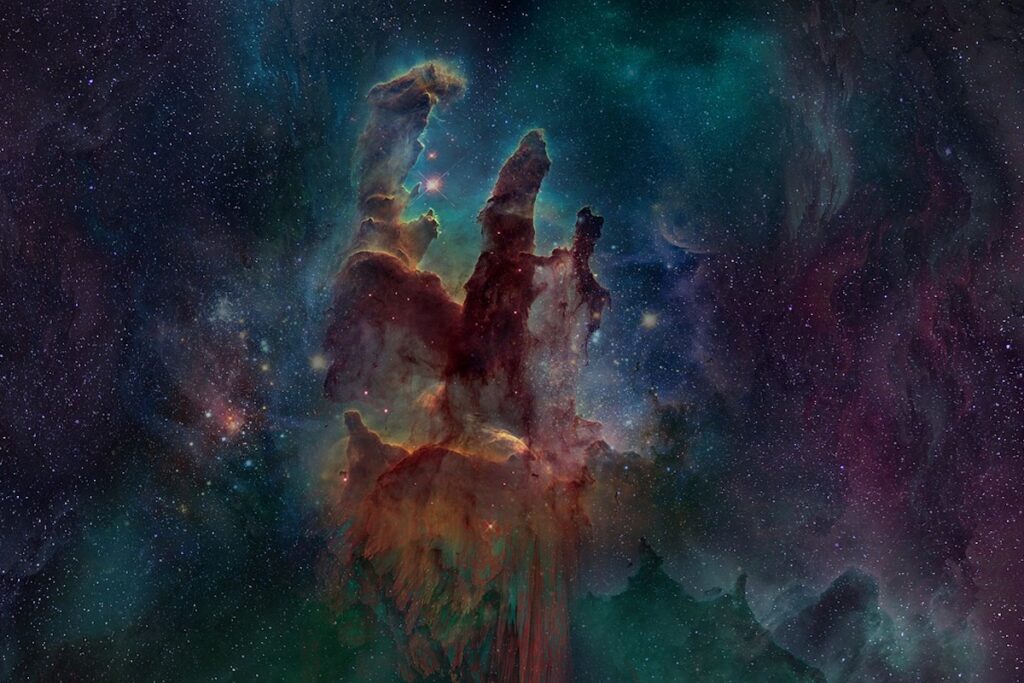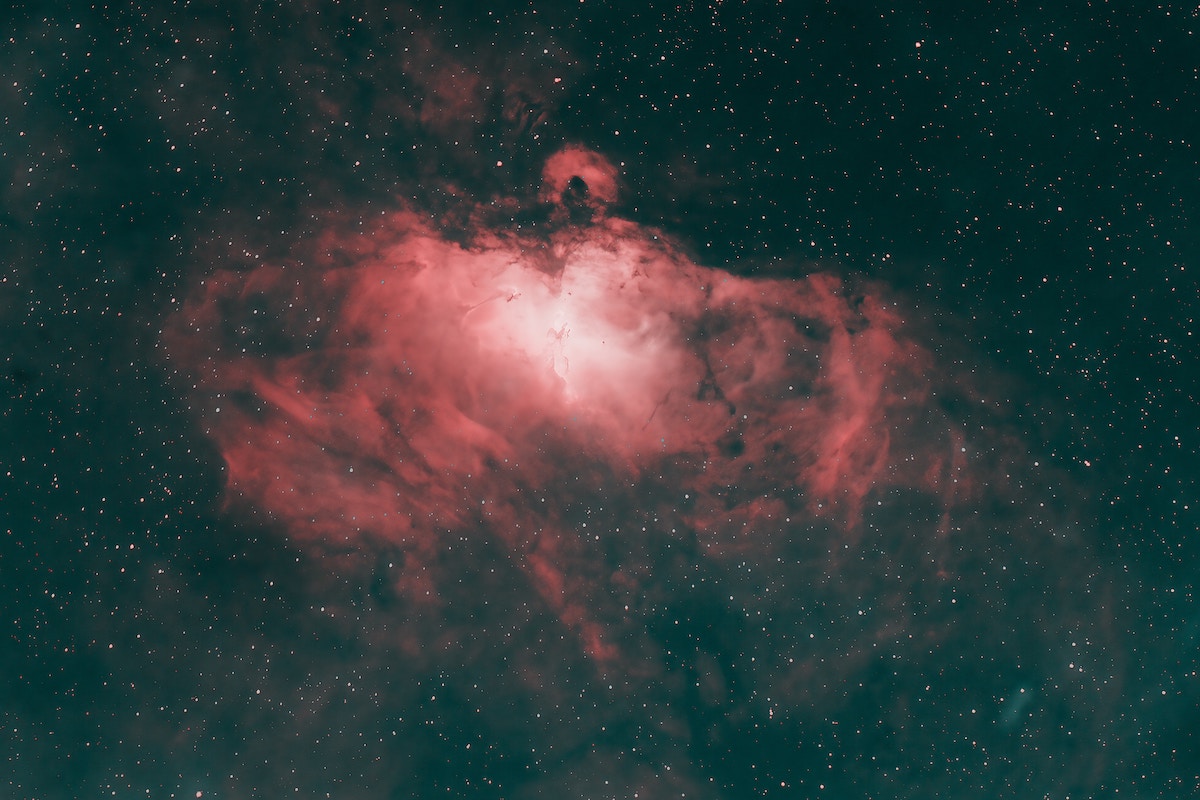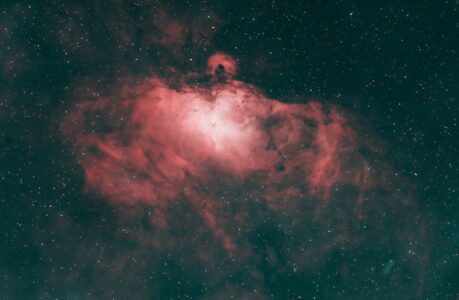The Eagle Nebula, also known as Messier 16 (M16), is a striking and vast interstellar cloud of gas and dust located in the constellation Serpens. It is one of the most recognizable and photographed objects in the night sky, thanks to its awe-inspiring pillars of gas and dust that resemble towering columns of smoke and flames. The nebula is approximately 7,000 light-years away from Earth and spans across a region of about 70 light-years.
One of the most intriguing features of the Eagle Nebula is the Pillars of Creation, which were captured in stunning detail by the Hubble Space Telescope in 1995. These pillars are enormous columns of gas and dust, several light-years in length, that are actively forming new stars. The Pillars of Creation are a popular subject for astrophotographers and have become an icon in popular culture.
The Eagle Nebula is a stellar nursery, where massive clouds of gas and dust collapse under their own gravity to form new stars. As the gas and dust are compressed, they heat up and glow brightly, emitting intense radiation that ionizes the surrounding gas, causing it to glow with different colors. The bright pink and red hues seen in the Eagle Nebula are caused by ionized hydrogen gas, while the blue and green colors are from dust particles reflecting starlight.
Aside from the Pillars of Creation, the Eagle Nebula is also home to a large number of young and hot stars, which can be seen in the form of bright clusters scattered throughout the nebula. These young stars are incredibly luminous and emit vast amounts of energy, heating up the surrounding gas and dust and causing it to glow brightly.
In recent years, astronomers have discovered that the Eagle Nebula is also a site of intense activity, with new stars forming at a rate of approximately one every three years. They have also observed a number of high-velocity jets of gas and dust shooting out from the surface of the nebula, which are believed to be caused by the powerful magnetic fields generated by the newly formed stars.
Can I see the Eagle Nebula from ireland?
Yes, it is possible to see the Eagle Nebula from Ireland, but it may be difficult to observe with the naked eye due to the nebula’s faintness. The best way to view the Eagle Nebula is with a telescope or binoculars.
You will also need a clear night with minimal light pollution to get the best view. If you have access to a telescope or binoculars, you can try locating the constellation Serpens in the night sky, which is where the Eagle Nebula is located. Once you have found the constellation, you can look for the distinctive shape of the nebula and try to observe it.
How do I find the Eagle Nebula (M16) from ireland?
To find the Eagle Nebula (M16) from Ireland, you first need to identify the constellation Serpens, which contains the nebula. Serpens is located in the southern part of the sky and can be visible during the summer months.
To locate Serpens, look towards the south-southeast around midnight during the summer months. You should be able to see the bright star Vega in the constellation Lyra, which can be used as a guide. From there, look towards the south-southeast and you will see a group of stars that form a curved shape that resembles the letter “J”. This is the constellation Serpens, which is divided into two parts: Serpens Caput (the head) and Serpens Cauda (the tail).
To find the Eagle Nebula, you need to look in the eastern part of Serpens Caput, near the border with the constellation Scutum. The nebula is located about 5.5 degrees east-northeast of the star Delta Serpentis. You may need binoculars or a telescope to see the nebula, as it is a faint object and can be difficult to spot with the naked eye.
Once you have located the Eagle Nebula, take your time to observe its beauty and appreciate the wonder of the universe.
The Pillars of Creation
The Pillars of Creation are a series of enormous columns of gas and dust located within the Eagle Nebula (M16). These pillars were first observed by the Hubble Space Telescope in 1995 and quickly became one of the most iconic and recognizable images in astronomy.
The Pillars of Creation are located within a region of the Eagle Nebula that is actively forming new stars. The pillars are made up of dense gas and dust that is being eroded away by the intense radiation and winds from nearby hot, young stars. However, the denser parts of the pillars are still able to resist the erosion, and as a result, they remain standing tall like massive columns of smoke and flames.

The pillars are several light-years in length and are actively forming new stars within their dense cores. The radiation from the young stars located around the pillars is causing the gas and dust within the pillars to heat up and glow brightly, creating a stunning visual display of pink and red hues.
Despite their beauty, the Pillars of Creation are also a stark reminder of the fleeting nature of the universe. Because of their proximity to the young, hot stars in the region, the pillars are being slowly eroded away and may not last for much longer in astronomical timescales. In fact, recent studies suggest that the pillars may have already been destroyed by a supernova explosion, but because of the vast distance between us and the Eagle Nebula, we will not know for another thousand years.
Regardless of their ultimate fate, the Pillars of Creation are a breathtaking reminder of the beauty and power of the universe, and their image will continue to inspire and captivate us for generations to come.
Why are they called the Pillars of Creation?
The Pillars of Creation within the Eagle Nebula (M16) are so named because they are actively forming new stars within their dense columns of gas and dust. The name “Pillars of Creation” was coined by scientists in reference to the biblical story of creation in the Book of Genesis, in which God creates the world in seven days.
The name is also fitting because the pillars themselves are a testament to the power of creation in the universe. They are towering columns of gas and dust, several light-years in length, that are actively shaping the formation of new stars. The dense cores of the pillars are where new stars are born, as the gas and dust are compressed and heated up by the intense radiation from the young stars in the region.
The Pillars of Creation are not only a beautiful and awe-inspiring sight but also a reminder of the dynamic and ever-changing nature of the universe. While they are currently standing tall and actively forming new stars, the intense radiation from nearby stars is slowly eroding away the pillars, and they may not last forever. But for now, they stand as a stunning example of the power of creation in the universe and will continue to captivate astronomers and space enthusiasts for generations to come.

